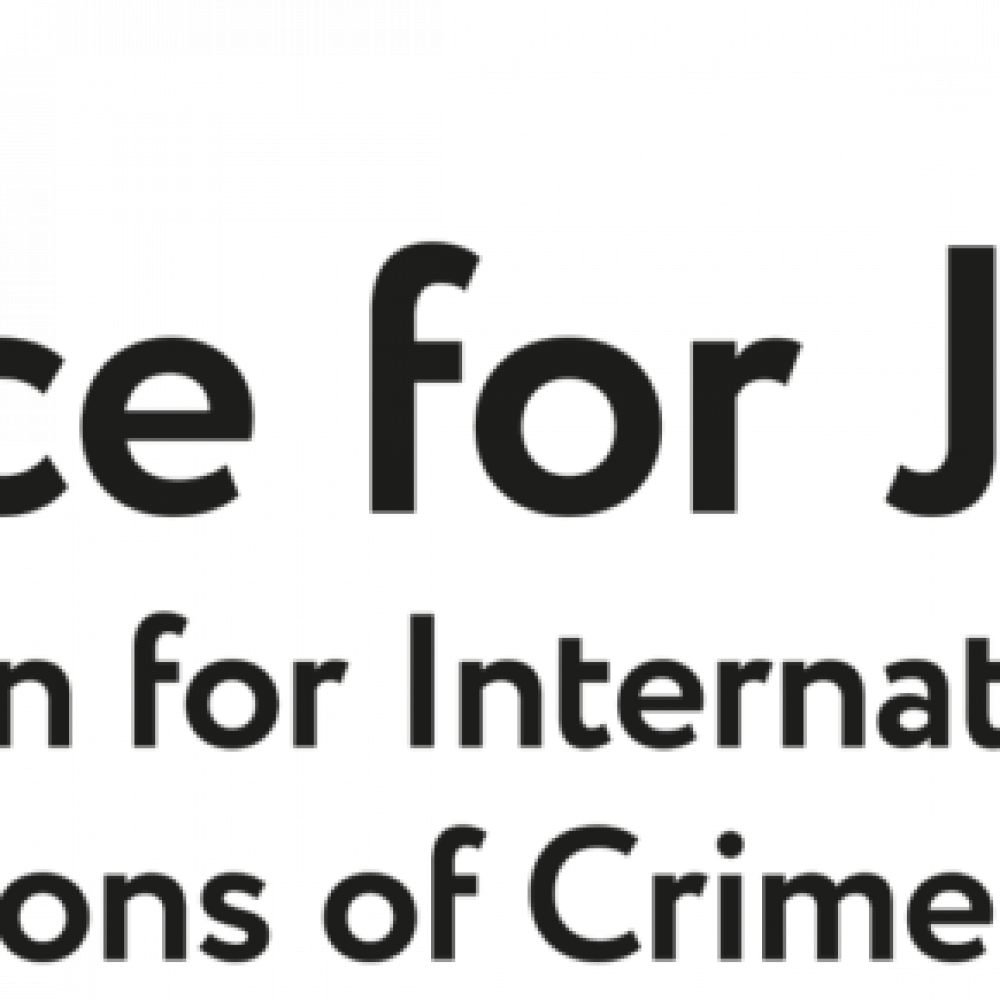AUTHOR OF THE REPORT: THE COMMITTEE TO PROTECT FREEDOM OF EXPRESSION (CPFE)
PHOTO: ARMENPRESS
1/ KEY FINDINGS
In Armenia, 163 attacks/threats against professional and civilian media workers and editorial offices of traditional and online media outlets were identified and analysed in the course of the 2023 study. Data for the study were collected using content analysis from open sources in Armenian, Russian, and English. A list of the main sources is provided in Annex 1.
- Compared to 2022, the total number of recorded incidents in 2023 increased by 11%. Initially, the deterioration of the situation may seem insignificant, but this is nevertheless an alarming sign since in 2022 there was a 38% reduction in attacks compared to 2021.
- The number of physical attacks against media workers continued to decline in 2023. There was a fourfold decrease in the total number of incidents compared to 2022. Recorded attacks on journalists and videographers were carried out mainly during their coverage of mass events.
- At the same time, the number of attacks and threats of a non-physical nature (as well as cyber-attacks) doubled: from 23 in 2022, to 46 in 2023.
- In 2023, 111 cases of attacks via judicial and/or economic means were recorded, this is almost 10% more than in 2022. As in previous years, these methods were most commonly employed by the authorities, who perpetrated more than 60% of these incidents.
- In 2023, the authorities put forward at least 2 regressive bills that threatened freedom of speech and media activity. One of them has been adopted and has become law.
2/ THE POLITICAL SITUATION AND THE MEDIA IN ARMENIA
In reports from international organisations published in 2023, both positive and negative trends in the fields of freedom of speech and media activities in Armenia were mentioned. In general, the country has improved its position in these organisations’ ratings. In the annual World Press Freedom Index, published by Reporters Without Borders (RSF), out of a total of 180 countries, Armenia has moved up two places – from 51 in 2022 to 49 in 2023. According to RSF, this is the leading position in the region in terms of freedom of speech. Neighbouring Georgia ranked 51st, while Azerbaijan, Turkey and Iran came 151st, 165th and 177th respectively.
In its annual report “Nations in Transit,” the international human rights organisation Freedom House, assessing media freedom in Armenia, awarded the country 3 points. In 2022 the country was given 2.75.
2023 was a year of significant difficulty for both Armenia and its people. On 19 September, after a 9-month blockade of Nagorno-Karabakh, Azerbaijan launched a full-scale military attack. As a result, 100 thousand of its residents were forced to leave their homes and move to Armenia. Events in Nagorno-Karabakh posed a difficult question to Armenia: whether to enter into a new armed conflict with Azerbaijan to protect Karabakh Armenians. The imbalance of forces was such that Armenia, which had not yet recovered from their heavy defeat in the 44-day war of 2020, would most likely lose a new war and be forced to capitulate. As a result, Yerevan decided to refrain from armed intervention in Karabakh. Moreover, Prime Minister Nikol Pashinyan began to more actively declare his desire to establish a peace treaty with Azerbaijan based on mutual recognition of territorial integrity.
As a result of this, radical opposition in Armenia accused the government of betraying national interests, capitulation, and inability to resist external threats. This rhetoric coincided with Moscow’s claims towards Pashinyan’s government that the current situation is a consequence of Yerevan’s rapprochement with the West and distancing from Russia, squeezing it out of the South Caucasus region.
The internal political confrontation was also aggravated by the September elections to the Council of Elders of Yerevan, during which the radical opposition announced its intention to take power in the capital, in order to remove Pashinyan. The ruling party claimed that it was fighting against a “fifth column”, controlled by outside powers.
This internal political confrontation in turn affected the work of the media. Polarised media outlets (depending on the interests of the party or group they served) used all possible means to discredit their opponents. Fake news, disinformation, libel, and slander have become widespread.
In this situation, the number of lawsuits against journalists and media outlets has increased, and cases of attacks and other methods of pressure on media workers have become more frequent. It is worth noting that most of these lawsuits were initiated by government officials.
А number of regressive legislative initiatives related to the media caused serious concern among journalists. One such law was a package of bills, based on the draft of the new RA Law “On State Secrets” which included an addition to the Law “On Freedom of Information”, which gives government bodies the right to reject requests for official comments if it contains “official information for limited distribution.” This vague wording intentionally leaves it open to misinterpretation and abuse, as almost any official document can fall under this provision. Despite strong opposition, the law was adopted.
Another alarming initiative was the bill “On Environmental Information” proposed by a deputy from the ruling party, which contained unreasonable restrictions, which were contrary to international standards, on the provision of information related to the environment. As a result of the criticism and persistent efforts of the media, environmental and other public organisations, this bill was withdrawn by those who proposed it. It’s worth pointing out that the initiative of the Ministry of Justice and the relevant parliamentary commission, together with several media organisations, prepared draft amendments and additions to the Law “On Mass Information”. This was seen to be the beginning of a level of cooperation between the authorities and public professional organisations, aimed at reforming the media legislation based on European standards.
THE SITUATION IN NAGORNO-KARABAKH AND ITS IMPACT ON THE MEDIA IN ARMENIA
During the blockade and the outbreak of the humanitarian crisis in Nagorno-Karabakh, the socio-political situation also worsened significantly. Various party groups, relying on their external connections, had different views on how best to resolve the situation. Rallies and demonstrations were a constant occurrence. Under these conditions, the work of journalists became extremely difficult, with illegal restrictions, various methods of pressure and physical violence being used against media workers. Their rights were violated by both representatives of local authorities and Russian peacekeeping forces. This is supported by the following facts:
- On 11 July 2023, in the capital of Nagorno-Karabakh Republic, Stepanakert, Hayk Ghazaryan, a correspondent for the CivilNet news website, was assaulted. A group of people ambushed and tried to kidnap the journalist. When this failed, they brutally beat him. Two days before the attack, while Ghazaryan was covering a protest rally in Stepanakert, a policeman approached him, snatched his phone, deleted the footage and then gave it back.
- On 26 August 2023, a member of the Russian peacekeeping forces in the zone of the Armenian-Azerbaijani conflict obstructed the work of Radio Liberty correspondent Tigran Ovsepyan. This occurred in an area which was not the responsibility of the peacekeeping forces. The serviceman, without any explanation, stopped a media representative from filming dozens of residents of Nagorno-Karabakh who had arrived there through the Lachin corridor.
- On 27 December 2022, 11 Armenian media organisations issued a joint statement expressing concern that Russian peacekeeping forces were preventing Armenian journalists from travelling to the part of the Lachin corridor where Azerbaijanis, described by official Baku as “environmental activists,” blocked the only road connecting Nagorno-Karabakh with Armenia and the outside world. Film crews from Radio Liberty, news websites Factor.am and Civilnet, and the “Asparez” journalists faced such a ban. They were prevented from collecting and publishing important information.
3/ GENERAL ANALYSIS OF ATTACKS
In 2023, a total number of 163 attacks against journalists and media workers was recorded in Armenia, 11% more than in 2022. The number of attacks of a physical nature decreased by 3.5 times compared to 2022, while the number of attacks of a non-physical nature and/or cyber-attacks increased twofold. The number of attacks via judicial and/or economic means has increased by approximately 10%. It is worth noting that in 2023, all court cases against journalists and media outlets, except two, contained demands for prosecution for insults, slander, and reputational damage.
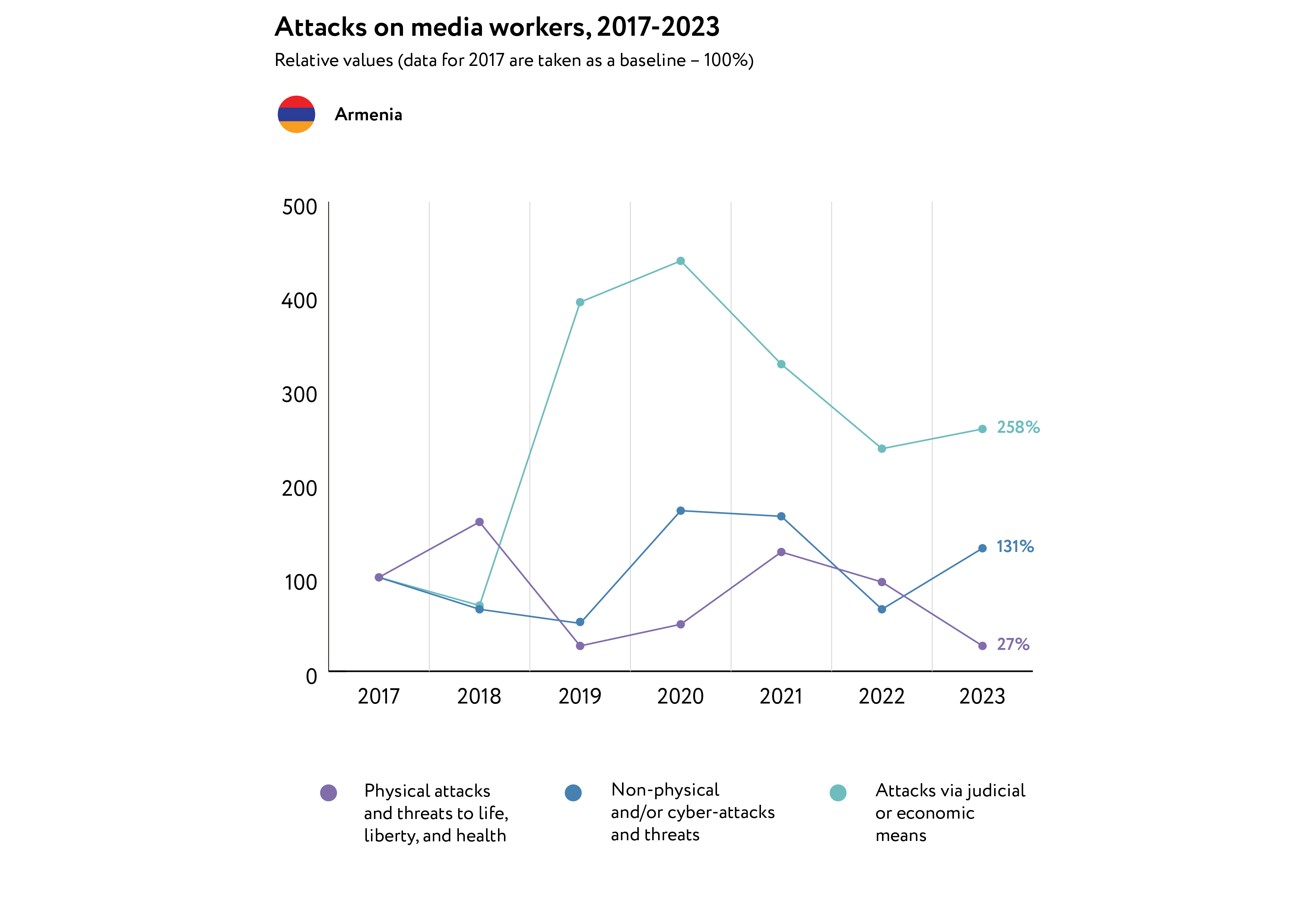
In 2023, 103 attacks were initiated by government officials and 51 by non-government officials. 8 were carried out by unknown individuals. One attack carried out by Russian peacekeeping forces was also recorded.
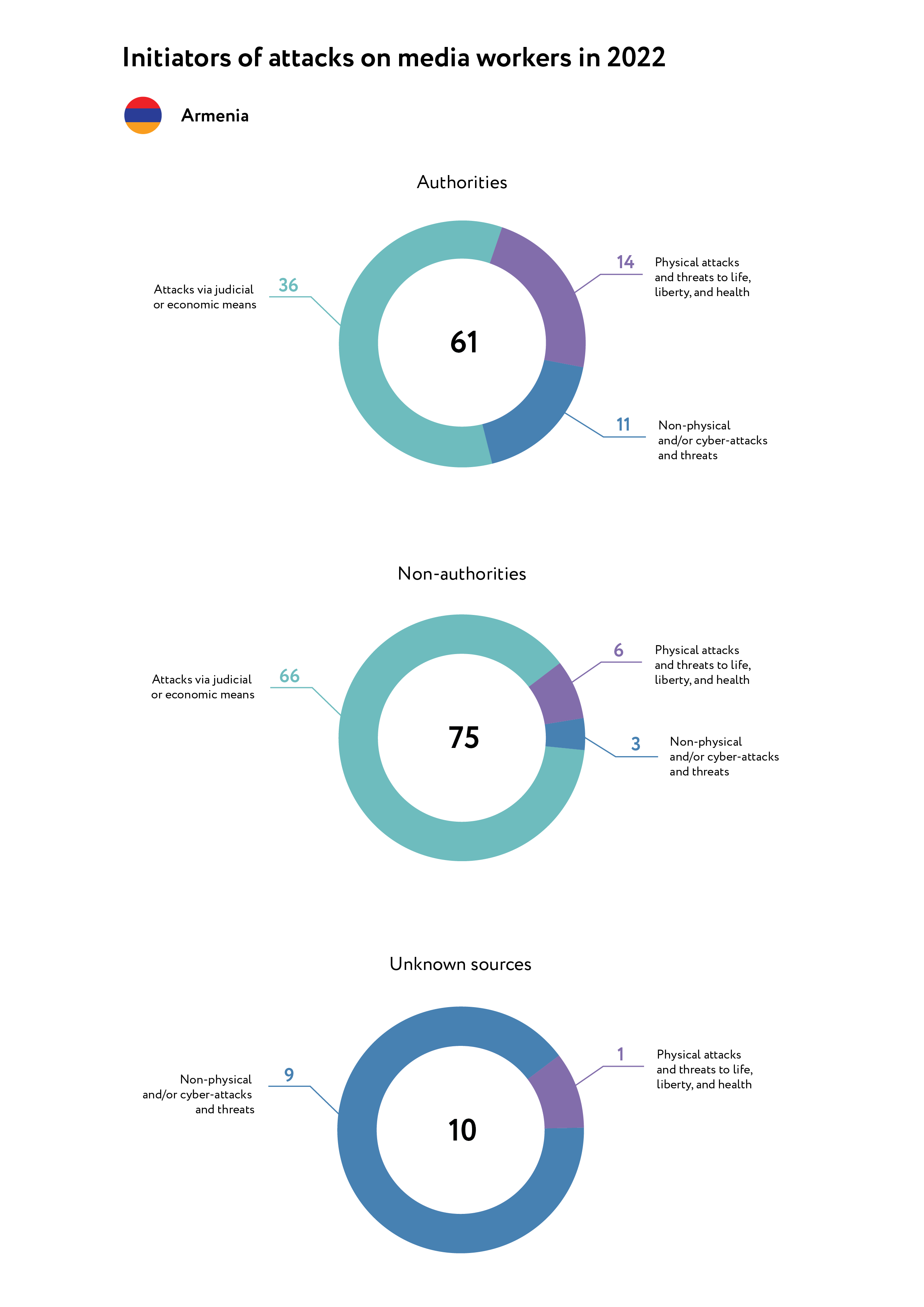
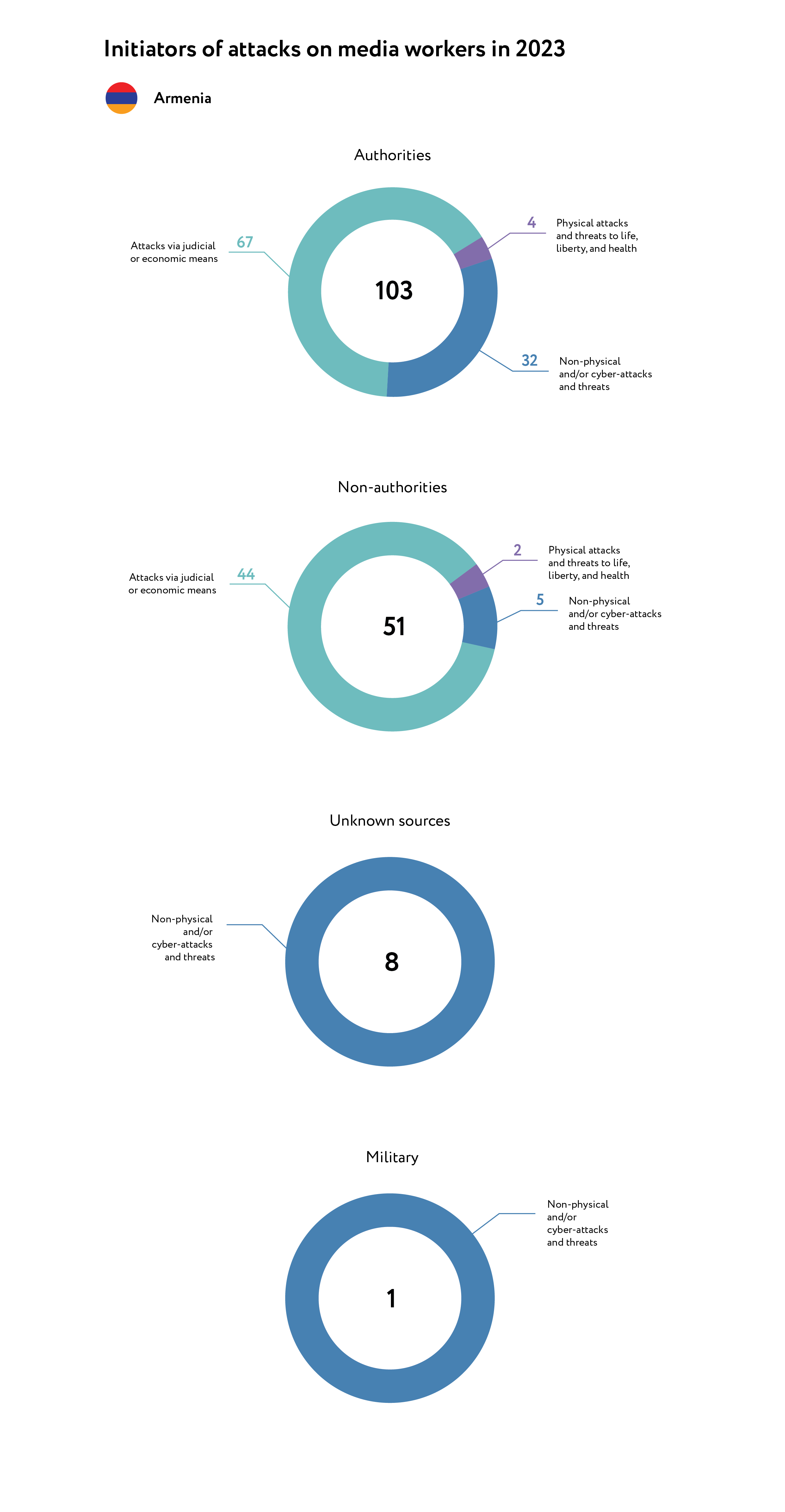
The main factors that led to violations of the rights of journalists and the media were:
- General aggravation of the socio-political situation in Armenia due to the crisis around Nagorno-Karabakh, which resulted in the resettlement of more than 100 thousand people to the Republic of Armenia. Politically biased coverage of these events in the media affiliated with various parties and figures caused intolerance towards such publications in the opposing camps and segments of society supporting them;
- Extremely tough political struggle, leaks of incriminating evidence and offensive rhetoric during the pre-election campaign and the elections to the Council of Elders of Yerevan – all this was reflected in the media and social networks;
- The ongoing polarisation of the media, the overwhelming majority of media outlets serving the interests of specific political forces to the detriment of public interests, the desire to discredit opponents at any cost, disregarding journalistic ethics.
4/ PHYSICAL ATTACKS AND THREATS TO LIFE, LIBERTY AND HEALTH
In 2023, a significant (3.5 times) decrease in physical attacks against media workers was recorded. This continues the trend seen in 2022 when there were 1.3 times fewer incidents. However, each case of physical force against journalists should be considered an extraordinary event, requiring public condemnation and effective measures by law enforcement agencies to bring the perpetrators to justice.
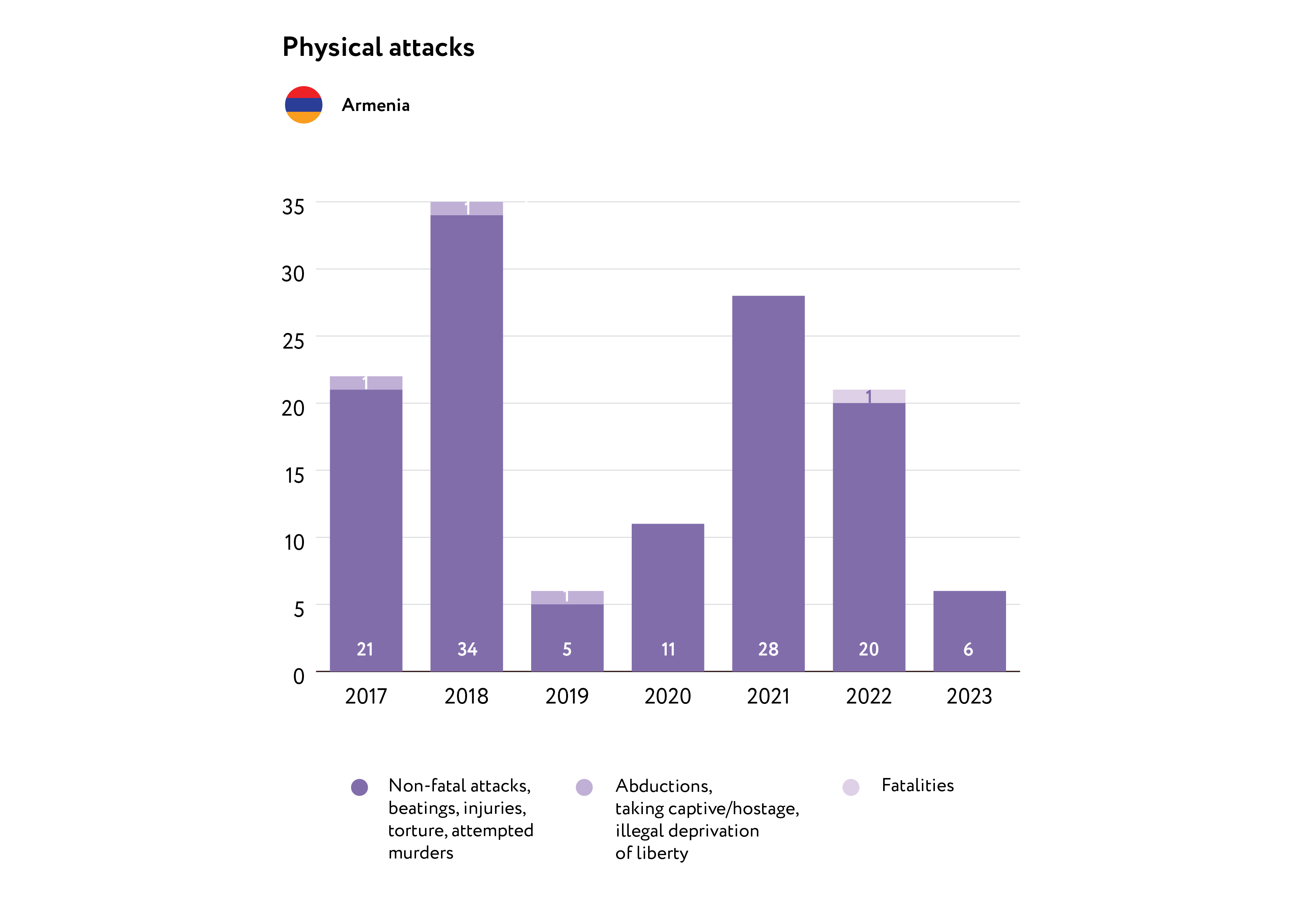
Of the 6 recorded attacks, 5 incidents occurred while covering mass political events such as election rallies, demonstrations and protests. Of these incidents, 4 were initiated by government officials and 2 by non-government officials. These incidents include:
- On 15 September, on the last day of the election campaign to the Council of Elders of the city of Yerevan, during a procession of supporters of the candidate from the ruling “Civil Contract” party, Tigran Avinyan, a participant insulted and struck the editor of the news website NewDay.am Ani Gevorgyan.
- On 19 September, police used stun grenades to disperse the demonstrators during a mass opposition protest near the building of the Government of the Republic of Armenia. As a result, along with several participants of the rally, Anush Mkrtchyan, a correspondent for the online outlet Hetq.am, was injured. According to the medical report, the journalist received shrapnel wounds that caused superficial skin burns.
- On 20 October in Yerevan, at the representative office of the Nagorno-Karabakh Republic in Armenia, authorities of the unrecognised republic interfered with the activities of Armenian journalists during a protest of Karabakh residents who were forced to move to Armenia. The president of the unrecognised republic, Samvel Shahramanyan, pushed Factor.am journalist Arpi Akopyan, while people from Shahramanyan’s team tried to snatch the phone from Channel 5 correspondent Arpi Sukiasyan while she was filming the event. At the same protest, Narine Ghukasyan, a correspondent of the “Yerkir Media” TV company, was assaulted while performing her professional duties. The journalist was knocked unconscious by one of the protesters. She was given first aid by a nearby police officer, after which she continued to cover the event.
- On 11 December, the editor of the information site NewDay.am, Ani Gevorkyan, tried to take a photograph of Prime Minister Nikol Pashinyan leaving a government building, but security officers prevented her from doing so. In response to the journalist’s protests, law enforcement officials cited legal requirements. They also used physical force against the journalist, forcibly removing her from the scene.
5/ NON-PHYSICAL AND/OR CYBER-ATTACKS AND THREATS
In 2023, the number of non-physical attacks, including cyber-attacks, doubled compared to 2022. The main methods of pressure on media representatives, as in previous years, were the illegal obstruction of professional activities (27 incidents) as well as bullying, intimidation, pressure, threats of violence and death, including online threats (10 cases). In 70% of cases, such attacks were carried out by government officials.

- On 10 January, some opposition media were denied access to a press conference held by Prime Minister Nikol Pashinyan. These included journalists from the television companies “Yerkir Media” and “Para TV”, news websites Oragir.news, NewDay.am, MediaHub.am, PastInfo.am and Yerevan.today. Diana Davtyan, a journalist from the pro-government television company Free News, was also not allowed into the press conference. She was told that she had arrived 10 minutes early.
- On 14 March, journalists from the TV companies “Yerkir Media” and Ararat TV, news sites NewDay.am, Meganews.am, Kavkaz-uzel.eu, Yerevan Today, Lragrogh.com, Infocom.am, newspapers “Iravunk” and “Azg” andthe news agency “Noyan Tapan” were not granted accreditation to cover a press conference of Prime Minister Nikol Pashinyan.
- On 19 April, Narek Kirakosyan, a correspondent for the Factor.am news site accredited by the National Assembly of the Republic of Armenia, tried to film Prime Minister Nikol Pashinyan in the parliament meeting hall from the press box, but was prevented from doing so by a security officer. The journalist was prohibited from filming close-ups.
- On 20 July, during public hearings at the Vanadzor City Hall, Acting Secretary of the Administration, Hayk Virabyan, interfered with the professional activities of Lori TV journalist Lusine Sargsyan, prohibiting her from filming. The official demanded that she show her accreditation, despite this not being required by law.
- On 31 August, in the Yerevan Court of General Jurisdiction, at an open hearing in a criminal case concerning the explosion at the capital’s Surmalu fair, the film crews of the Public Television of Armenia, as well as the information portals Factor.TV and News.am at first were banned from broadcasting live, and then prevented from filming at all. Ten minutes into the hearing, the judge ordered that the filming be stopped, although the defendants did not oppose any media coverage. When Public Television correspondent Tatev Khachatryan introduced herself and demanded an explanation, the judge reprimanded her saying she was interfering with the proceedings, threatening the journalist with more severe sanctions.
In 2023, 3 cases of DDoS and hacker attacks on the media were recorded, as well as 5 cases of online bullying, intimidation, pressure, threats of violence and death carried out by unknown individuals. Here are some examples of such attacks:
- On 12 January, a correspondent for the news website Arabot.am, Ripsime Dzhebejyan, posted screenshots of threats she’d received on Facebook from bots and anonymous users. The reason for such attacks against her was her professional activity: on 10 January, at a press conference of Armenian Prime Minister Nikol Pashinyan, Dzhebejyan asked him what punishment he could expect for his sins.
- On 14 March, the YouTube channel of the information portal Arabot.am was hacked. According to editor Anna Israelyan, all video materials on the channel were erased. The hacking occurred after the channel announced the forthcoming broadcast of a journalistic investigation titled “How Much Did Revolutionary Officials Enrich Themselves During a Year of War?”
- On 22 March, offensive comments towards Arabot.am journalist Ripsime Dzhebejyan were left on the outlets’ Facebook page. The posts, made by bot accounts, contained offensive language and accusations that Dzhebejyan was spreading false information about the Armenian government.
- On 26 July, journalists from NewDay.am and Aravot.am Ani Gevorgyan and Ripsime Dzhebejyan were harassed on Facebook by various users, including bots, for questions addressed to Prime Minister Nikol Pashinyan during his press conference. The comments towards journalists contained threats and insults.
- On 18 September, the online outlet Hetq.am, part of the public organisation “Investigative Journalists”, came under a DDoS attack, causing serious difficulties in accessing the site. IT specialists later helped to resolve the problem.
- On 22 November, an attack was carried out on the news website 7or.am.
- On 10 December, there was a huge influx of insults, threats and hatred on social media aimed at journalist Marut Vanyan, who was forced to move from Nagorno-Karabakh to Armenia along with more than 100 100,000 refugees. The reason for the attack was the series of photographs he published, showing the deplorable state of the streets in the city of Razdan and asking the question “Does this city have a mayor?” Shortly after the publication, the mayor’s “defenders” began to write offensive statements against Vanyan, threatening him and discriminating against him by pointing out his origin. The journalist was forced to close his Facebook page.
- At least 5 journalists were targeted by Pegasus spyware, which was used to spy on Armenian media workers covering the military conflict with Azerbaijan. The targets included Armenian human rights activists, academics and government officials, two media representatives who wished to remain anonymous, and three journalists: “Radio Azatutyun” journalists Karlen Aslanyan and Astghik Bedevyan, and the co-founder of the now-defunct independent TV company “ArmNews” Samvel Farmanyan.
5/ ATTACKS VIA JUDICIAL AND/OR ECONOMIC MEANS
As in previous years, court trials and litigation remained the main methods of pressure via judicial and/or economic means. In 2023, 48 new court cases against journalists and media outlets were initiated, 14% more than in 2022.
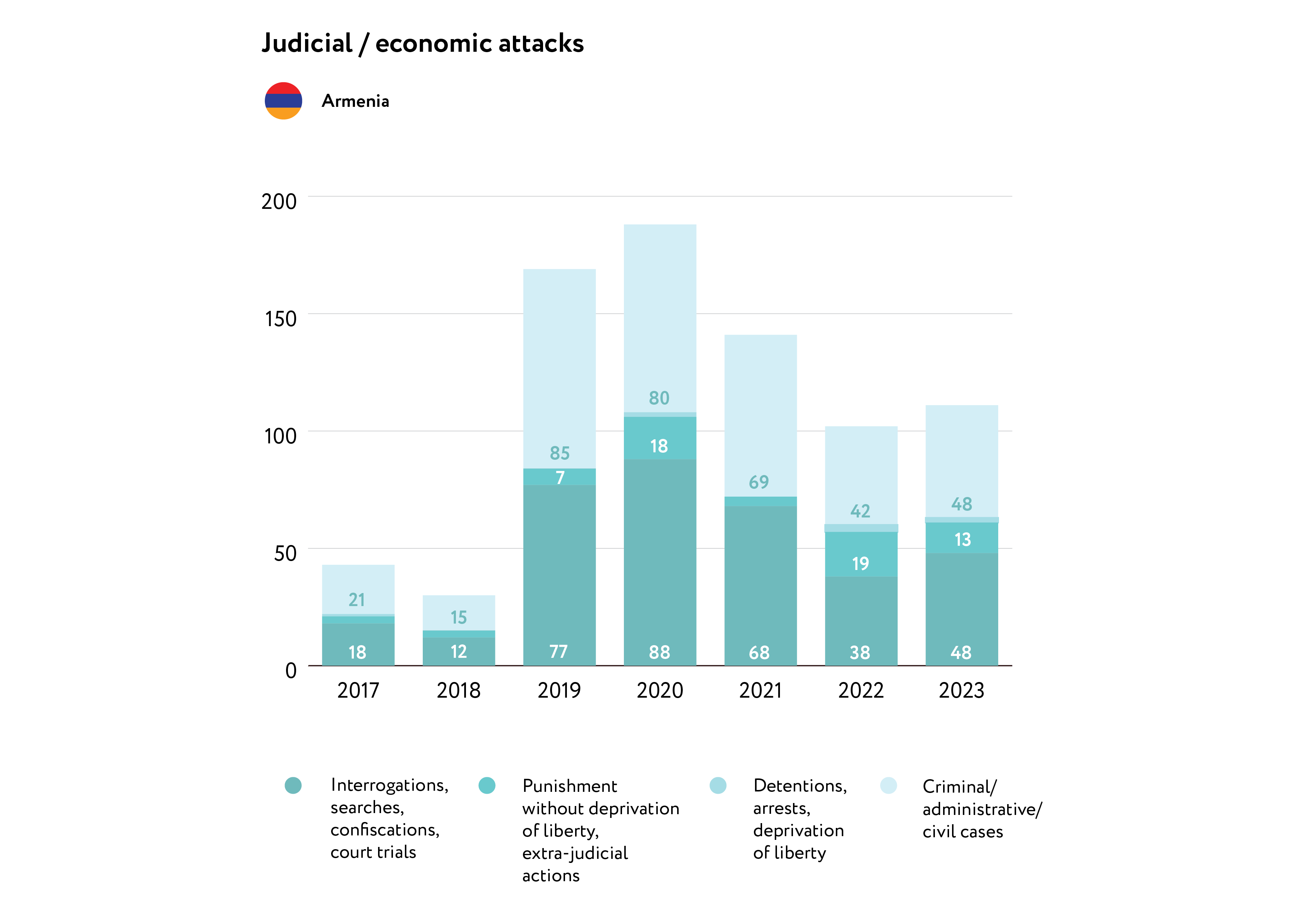
All claims demanded prosecution for damage to honour, dignity, and reputation; and violation of privacy in civil proceedings and sought refutation of information considered slander. More than half of these claims (27) were initiated by government representatives:
- On 5 January, Deputy of the National Assembly of the Republic of Armenia Khachatur Sukiasyan, representing the ruling “Civil Contract” faction, filed a lawsuit in the Yerevan Court of General Jurisdiction against “Ailentrank Media” LLC and “Media Plus” LLC, demanding that the outlets apologise, refute “slanderous” information, publish the court decisions and pay monetary compensation. This lawsuit was due to material published on 5 December 2022, on the website Alternativ.am (part of “Ailentrank Media” LLC). The publication was entitled “Black Clouds of Velvet “Racketeering” over the Kirov plant: The Buyer of the Enterprise Put its Own Bank Up for Auction”. It was then republished on the Yerevan.today website with reference to the original source. The claim is pending.
- On 19 April, the Chairman of the National Assembly of the Republic of Armenia Alen Simonyan filed a lawsuit in the Yerevan Court of General Jurisdiction against the founder of the news site MediaHub.am (LLC of the same name), demanding that they refute “slanderous” claims and pay compensation. This was due to a publication posted on the website on 13 April entitled “The government, bypassing the competition, made a 79 million dram agreement with the company of Alen Simonyan’s brother.” The claim is pending.
- On 13 June, the Commission for the Prevention of Corruption and its chairman Aykui Arutyunyan, filed a lawsuit in the Yerevan Court of General Jurisdiction against Sevak Mamyan, the founder and editor-in-chief of the news website Infocom.am (part of the public organisation “Information Committee”), as well as journalists Mkrtich Karapetyan and Katya Mamyan demanding that they publicly refute “slanderous” information. This was due to an article published on 6 May entitled “Members of the family of the chairman of the Commission for the Prevention of Corruption have not submitted income declarations for two years, and there has been no investigation.” Before going to court, the Commission sent a refutation text to the editor, but the outlet refused to publish it. The claim is pending.
- On 27 September, the head of the Central Administrative District of the capital, Samvel Ghukasyan, filed a lawsuit in the Yerevan Court of General Jurisdiction against the Editorial Board of the “Zhoghovurd” newspaper demanding they publicly apologise, publish a court decision, refute “slanderous” information, and pay compensation. The lawsuit was due to articles published on 26 August and 9 September in the “Zhoghovurd” newspaper and on the Armlur.am website. The articles stated that the head of the district was ignoring pressing issues and, together with his administration, was campaigning in favour of the ruling party in the elections to the Council of Elders of Yerevan. They stated that this man (the head of the district) was no stranger to this kind of behaviour. The claim is pending.
- On 26 October, the Chairman of the National Assembly of the Republic of Armenia, Alen Simonyan, filed a lawsuit in the Yerevan Court of General Jurisdiction against the Chairman of the “Hayeli” Press Club (Hayeli.am) and journalist Angela Tovmasyan. He demanded an apology for “insults” and monetary compensation. The lawsuit was due to a publication by Angela Tovmasyan on the Tert.am website on September 21. This contained a comment to the Speaker of Parliament – “In the end, we must leave a free, independent and peaceful Armenia as a legacy to our children.” The claim is pending.
There are 4 recorded cases of court verdicts on previously filed claims, which ordered the removal/blocking of publications, the issuing of refutations, and compensation/legal cost payments:
- On 8 September, the court partially satisfied a lawsuit filed on 9 June 2022, by the Deputy Chairman of the National Assembly of the Republic of Armenia, Akop Arshakyan, against the founders of the news websites ArmDay.am and Lurer.com in which the plaintiff demanded that they publicly refute “slanderous” information and pay compensation of 5 million drams (approx. $12,500). The court ordered the defendants to publish a refutation and, by way of joint participation, to pay the plaintiff 500 thousand drams (approx. $1,250) as compensation for libel and 35 thousand drams in fees. The judicial decision was not appealed.
- On 11 May, the court announced an act, according to which it partially satisfied the claim of the rector of Yerevan State University, Ovannes Ovannisyan, against the founder of the news website Yerevan.Today, obliging him to publicly refute “slanderous” information, to pay 500 thousand drams (approx. $1,250) in compensation, 50 thousand drams for legal services and 14 thousand drams in state fees. The lawsuit was filed on 27 August 2021, demanding a refutation of defamatory information and payment of compensation of 2 million drams, as well as a public apology for the insults and compensation of an additional one million drams.
- On 12 June, the court partially satisfied the lawsuit filed by citizen Arman Martirosyan on 22 December 2021, against the founder of the news website Exclusive.am demanding a public refutation and apology for the insult, as well as the payment of 3 million drams. The court ordered that the defendant publicly refute the statements discrediting the plaintiff and pay 170 thousand drams (20 thousand of which were state fees, the rest of which were attorney fees).
- On 27 April, the defendant (journalist of the Tert.am news website Ani Gevorkyan) in the lawsuit of the Vice-Chairman (now Chairman) of the RA Parliament Alen Simonyan, having gone through three courts of different levels, was forced to comply with the verdict. Gevorkyan was instructed to publish a refutation and pay the plaintiff 150 thousand drams as compensation for libel, 100 thousand in legal fees, and 7 thousand in state duty. The lawsuit, submitted on 13 May 2021, was due to Gevorkyan accusing Simonyan of organising a campaign of intimidation against her on social media.
In 3 cases, property was also seized, and the bank accounts of journalists/editorial staff were blocked:
- On 2 May, the Yerevan Court of General Jurisdiction accepted the lawsuit of the Vice-Mayor of Yerevan Tigran Avinyan (now the mayor of the capital) against LLC “168 Zham” (owner of the newspaper “168 Zham” and the website 168.am) and journalist David Sargsyan, demanding that the defendants refute information which damaged the honour, dignity and business reputation of the plaintiff. The claim also demanded compensation of 3 million drams for insults and 6 million drams for slander. In addition, the plaintiff submitted a petition asking the court to apply measures towards the property and bank accounts of the defendants. This measure was later cancelled in relation to the journalist but remained in force for the LCC. The lawsuit followed the publishing of a video entitled “Tigran Avinyan: a newly minted rich man” published on the 168.am YouTube channel, in which the author accuses the vice-mayor of economic and political corruption. The claim is pending.
- On 17 August, the ruling “Civil Agreement” party filed a lawsuit in the Yerevan Court of General Jurisdiction against the founder of the news website Fip.am (part of the public organisation “Union of Informed Citizens”) demanding they publicly refute “slanderous” information and pay compensation. The lawsuit was due to a video published on 21 July, called “The State Duma collects votes for Avinyan, using the administrative resources of other communities.” It’s worth mentioning that Tigran Avinyan will take part in the upcoming elections of the Council of Elders of Yerevan as a candidate from the ruling party and is likely a contender for the position of mayor of the capital. On 25 August, the claim was accepted. The court also granted the plaintiff’s request to impose prohibitions on the defendant’s property for 1 million drams (over $2,500).
Other incidents include:
- On 22 March, the editorial staff of the newspaper “Zhogovurd” received a letter from David Arakelyan, the head of the National Assembly apparatus of Armenia, containing a warning addressed to the editor-in-chief, Knar Manukyan. This was due to a photo report published on the Armlur.am website (part of the same media outlet), which showed parliament security officers gathered at the doors of the meeting hall in the parliament building. According to the sender, the media outlet violated a number of resolutions of the NA Chairman, which prohibit photos and videos being taken of security officers. The letter was preceded by a telephone call from the Parliamentary Information Service, which demanded that the publication be removed from the website.
- On 7 May, in Yerevan, security forces tried to detain a blogger from Anapa, Andrei Melnikov, who is wanted, presumably, in a criminal case for discrediting the Russian army (Article 280.3 of the Criminal Code). The man was able to escape with the help of local residents.
- On 25 September, during a protest on the premises of the Yerevan State University, David Sargsyan, a journalist working for the website 168.am, was detained on suspicion of hooliganism. He was later released.
ANNEX 1: OPEN SOURCES USED FOR GATHERING DATA (ARMENIA)
- Committee to Protect Freedom of Expression – a civic organisation operating in Armenia, engaged in studying the situation in the realm of freedom of speech and publishing periodic reports, as well as defending the rights of journalists and media outlets.
- Yerevan Press Club – an NGO, the principal goal of which is support and development of free, independent, and quality media.
- Media Initiatives Center – an Armenian NGO, the main mission of which is to create and disseminate free and independent content and by means of this to promote the all-encompassing and harmonious development of society.
- Hetq.am– the internet publication of the Armenian civic organisation Investigative Journalists.
- Freedom House – an international human rights NGO that evaluates and publishes reports on the level of freedom in 210 countries and territories worldwide, including on freedom of speech and media activity.
- Reporters Without Borders – an international NGO whose aim is to protect journalists who are being subjected to persecution for doing their job.
- The Committee to Protect Journalists – an international organisation engaged in defending the rights of journalists.
- DataLex.am – the database of Armenia’s judicial system.
- Region Research Center – an Armenian civic organisation that studies the regional problems of the South Caucasus, including those concerning media activity.
- Haykakan zhamanak [Armenian Times] – a daily newspaper.
- Factor.am – an Armenian multimedia news portal.
- Radio Azatutyun – the Armenian service of Radio Free Europe/Radio Liberty.
